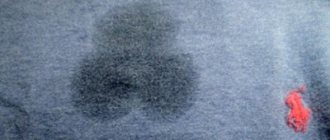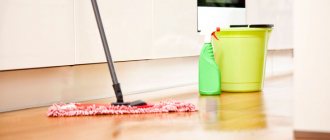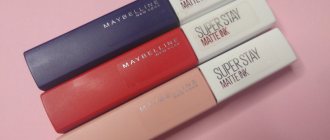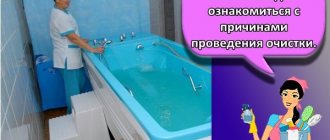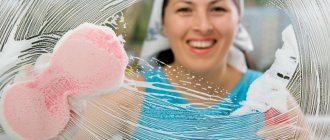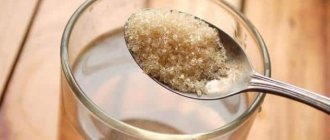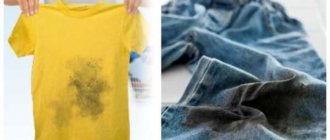Parquet is considered one of the most beautiful and stylish flooring options for residential premises. It is made from natural wood, so it is absolutely safe for human health. The material in question has high strength and durability. Proper care will help extend the life of this structure. From our article we will learn how to wash a parquet floor correctly.
What is
The first floors made from beautifully selected wooden planks appeared in Europe in the 13th and 14th centuries. This covering was made from several types of wood, using wood of different colors and structures to create patterns and ornaments on the floor. Individual parquet floorings were tightly fitted to each other using special grooves.
Modern parquet has different structures and special types. Separate floor planks are still in demand, but mosaic, panel and parquet boards are especially easy to assemble and decorative.
Brushes, mops and rags - the best way to wash parquet floors
There are several recommendations regarding the equipment used to clean parquet floors from dirt. For example, microfiber cloths are great for cleaning it. They are quite soft and absorb moisture well.
Only a special mop should be used - soft, without hard edges, so as not to accidentally scratch the base. It is best to use one that has a hygroscopic nozzle and a mechanical spin.
Use only soft mops
Some housewives expect to use a vacuum cleaner to wash parquet, but this unit is not suitable for such a delicate surface. It releases too much water, which can be absorbed into the wood and ruin the floor. An exception is special vacuum cleaners for parquet boards.
To sweep parquet floors, it is recommended to use a brush with natural soft bristles. It could be goat or boar hair. Synthetic brushes can only be used if they have soft and thick bristles.
Floor sweeping brush
Kinds
All types of parquet are distinguished by their natural composition. But installation methods, wear resistance and durability vary depending on the type, number of joints and layers.
Piece
Block parquet consists of individual planks with grooves and tenons for connection. They allow you to assemble a single piece of fabric into a common floor structure. The size of the parts is 50x7.5 centimeters, thickness is 1.5-2.2 centimeters.
This parquet is durable, fits into different patterns, and is easy to repair.
Mosaic
The mosaic, or typesetting, type consists of shields (side size - 40 or 60 centimeters), with the help of which exquisite patterns are assembled. The shields differ in the type of edges and the options for attaching them to each other. Under this type of parquet you can make an insulating layer on the floor.
Shield
Two-layer parquet, consisting of a lining made of fiberboard or boards and an upper decorative part made of small strips of hardwood. The shield has a significant size - sometimes up to 80x80 centimeters.
Parquet board
The main difference is that the board contains 3 layers of wood, the middle part is positioned so that the fibers lie perpendicular to the upper and lower layers. This gives the parquet board strength and durability. This material is convenient to lay on the floor and disassemble.
A few words about parquet
This type of flooring consists of a large number of small elements made from wood species such as maple, beech, birch, etc. Sometimes there are also quite exotic types of covering made from wood from plants growing in the tropics - bamboo, wenge, merbau . The material has a beautiful appearance, is quite durable and reliable, has excellent sound insulation properties and retains heat well in the house.
The structure of the parquet board
Comparative table of wood hardness for parquet
On a note! Parquet, despite the description above, is not an ideal type of flooring, as it does not like moisture and temperature fluctuations. The thing is that it is made of wood, which is capable of changing its size under the influence of environmental factors and reacts sharply to any fluctuations. This is what basically causes all the problems that owners of parquet floors experience.
Parquet comes in several types - piece, mosaic or typesetting, panel and in the form of parquet boards. Let's take a closer look at them.
Parquet
Table. Types of parquet.
| View | Description |
| Piece | This is the type of parquet we are familiar with, which is presented in the form of separate small strips, joined together using a tongue-and-groove connection system. The covering is made of hardwood and usually has a thickness of 15-22 mm with a length of individual elements of about 50 cm. The material has a long service life, is easy to repair, and can be laid in a variety of patterns. |
| Mosaic / Stacked | The material is represented by small shields measuring 40x40 or 60x60 cm, for which multi-colored small strips with a thickness of up to 12 mm are usually used. This parquet looks quite impressive and creates a mosaic effect on the floor (hence the name of the type). |
| Shield | Double-layer square-shaped material. The lower part of the shield is represented by a board or fiberboard, on which is located the upper part, assembled from small planks made of hard wood. Also, the base can be made of slats. The material is very easy to install, since panels are much easier to lay than individual planks. Their dimensions reach 80x80 cm, and thickness varies from 15 to 30 mm. |
| Art | The most expensive type of parquet, as it has a rather beautiful pattern. If the covering is completely assembled, then it can become a real work of art, and not just a floor. The material is installed, as a rule, in spacious halls - it will not look good in a small room. Usually made to order. |
| Massive | Parquet is made from solid wood, which is why its price is quite high. It resembles an ordinary piece, but has different dimensions - at least 8 cm wide and about 15 mm thick. |
| Parquet boards | A three-layer version of parquet flooring. It is made of several layers of wood, laid so that their grains are perpendicular to each other. Due to this, it is possible to achieve the strength of each board; they react less to fluctuations in humidity. The top layer is made of durable and expensive wood, the bottom layer is cheaper and simpler. The length of each board varies between 120-127 cm, thickness - from 7 to 23 mm. |
Parquet prices from
Tarquette parquet
The solid board has proven itself quite well. Just like piece parquet, it is made from natural wood of various species.
Main causes of pollution
A number of reasons have a negative impact on the condition of parquet. Ordinary dirt is absorbed into the wood, penetrates into the cracks, disrupts the structure and spoils the appearance.
Moisture
Wood absorbs moisture from the air and liquids spilled on the floor. Because of this, spots appear and color changes. Water attracts other contaminants - dust, debris.
Pets
Ubiquitous animals scratch the parquet with their claws, drag fatty food and favorite toys across the floor. The most ill-mannered ones may urinate on the floor. The damage caused to parquet by pets is usually the most significant.
Furniture items
Heavy furniture presses down on wooden parquet, and dirt accumulates in the dents, which is difficult to remove. There are also traces on the floor from moving furniture, chairs on wheels, rocking chairs.
Shoes
Shoes with heels, as well as with soles that leave marks due to poor quality paint, contribute to the contamination of parquet floors. Wet things, bags, and umbrellas thrown on the floor also stain the parquet flooring. Moisture combined with dirt is detrimental to parquet.
Rules of care
There are several conditions that must be unconditionally fulfilled:
- Do not perform wet cleaning frequently. Washing parquet floors every day will not lead to anything good.
- Use devices with delicate surfaces.
- Choose cleaning products carefully and carefully depending on the type of parquet.
- If scratches appear, repair the defects immediately. They not only spoil the visual appearance of the interior, but also contribute to greater absorption of moisture into the wood.
- Renew the coating regularly.
- Try to balance the microclimate of the room.
How to clean parquet floors
Dry cleaning is recommended for parquet flooring. You can remove dust using a vacuum cleaner with a soft brush that will not scratch the parquet flooring. They wash the floor infrequently, trying not to pour water or create puddles. This should be done only when necessary, when dirt cannot be removed using the dry method.
General cleaning is carried out once a year, in dry weather, when you can fully ventilate the apartment and quickly dry the floor. Use a hygroscopic cloth for washing, which can be wrung out well so as not to leave excess water on the parquet.
Important: handle the water container carefully so that puddles do not accumulate around it on the floor while the mop is wetted.
Mop
The parquet is washed with a mop that does not have sharp hard edges. The nozzle is microfiber, which is highly hygroscopic and quickly absorbs moisture. Models with a mechanical spin are ideal because they immediately remove excess water.
See also
Description of the Fly Lady home cleaning system and features for workers
Preparation
The first stage of cleaning parquet is to wipe the floor with a damp cloth to remove dust and identify contaminants that cannot be easily removed.
Removing stains
Even the cleanest owners have stains on their floors. Before you begin removal, you need to understand what they were formed from in order to choose the right removal method.
From tea, coffee, juice
Drink stains can be removed with a cloth soaked in a baking soda solution.
Fat
Fresh greasy stains are washed off with detergent, dissolving it well in water. Old stains are removed:
- Gasoline-based solvent. Then wash with soapy water.
- Cool the floor area thoroughly (using ice from the refrigerator), and remove the fat layer with a sharp knife. Then apply a clean cloth and iron it.
- Sprinkle a layer of starch onto the stain, cover with a thick cloth and iron several times.
Grease stains must be removed quickly so that the contamination does not penetrate deep into the wood.
Grown-in shoe marks
Dark marks from the soles are erased with a stationery eraser.
Cosmetical tools
Traces of cosmetics are removed with a cloth soaked in an alcohol solution or warm water and detergent.
Ball pen
Traces of ink are washed off with detergents, which are pre-diluted in water. A weak solution of vinegar or alcohol will also remove ballpoint pen stains from the floor.
Urine
When removing urine, it is necessary not only to remove the stain, but also to get rid of the smell. Urine leaks into the joints between the parquet elements; puddles must be wiped up immediately so that the wood does not become saturated. A rag is moistened with an alcohol solution and the floor is wiped. To get rid of the smell, leave a cloth moistened with alcohol on the floor until it dries.
Gum
Place any bag from the freezer on top of the stuck and smeared gum. When the chewing gum hardens, carefully remove it with a knife.
Blood
Undried blood is washed off with a napkin and cold water. Old stains are removed with ammonia.
Tar or resin
Such stains are first frozen, then scraped off with a knife. If necessary, use a resin solvent.
the washing up
The parquet is washed with water at room temperature. Use rags that can be wrung out well. They begin to wash the floor from the walls, without pressing on the mop so that the water is not absorbed too much. A few rules:
- Cleaning powders with abrasive components are not used.
- Do not use window or dishwashing detergents, only for parquet.
- Stains are cleaned in advance.
- The washcloth is always wrung out as much as possible.
Despite parquet’s dislike of water, the floor must be washed at least once every 2 weeks. The accumulation of dirt and the penetration of contaminants into the cracks spoil the appearance of the coating.
Completion
Finish wet cleaning by repeatedly passing the floor with a semi-dry cloth to remove stains. Then the rooms are thoroughly ventilated to reduce humidity and dry the parquet. Only after this the removed furniture is placed, carpets and rugs are laid out.
Washing vacuum cleaner
Even the best washing vacuum cleaners do not completely collect water after cleaning; the contact of parquet with water is prolonged. It is better not to use washing vacuum cleaners for cleaning parquet flooring.
Dry cleaning
Dry cleaning is the most preferable for parquet. The floor is wiped with a dry mop with soft attachments, sweeping away dirt and dust. Many vacuum cleaner manufacturers offer special models for dry cleaning of parquet, equipped with soft brushes. Leaders in quality are vacuum cleaners from Karcher and Bork.
Cleaning with a steam generator or steam mop
Steam mops and steam generators are not used for most types of parquet flooring. High pressure and hot steam are the enemy of delicate wood; joints expand. White streaks appear on the varnish and the wood darkens.
Can only be used for waterproof parquet, where the joints are sealed with sealant and the surface is not waxed.
Caring for varnished parquet
For a long time since the appearance of this type of flooring, parquet has not been treated with varnish. It was washed with plain water and then rubbed using special products and a clean rag. This was the only way to give the floor shine and chic. But I had to polish the parquet very often, which was tedious. Thanks to this, parquet manufacturers decided to varnish the material so that it retains its shine for a longer period. But varnished parquet, in addition to its advantages, also acquired disadvantages - now its surface could be easily scratched, which means that it had to be treated with even more attention.
Lacquered parquet floor
Before wet cleaning, the varnished coating must be cleaned with a vacuum cleaner - this allows you to remove sand and small stones, which under the rag could create an abrasive effect and spoil the surface. Only after this is the parquet wiped with a damp, well-wrung cloth, and then treated with a dry cloth.
Advice! To wash varnished parquet, it is recommended to use products specially designed for this purpose, which can be purchased in the store. It is also recommended to rub it with a special polish that has a water- and dirt-repellent effect.
Lobacare Remover - cleaning varnished parquet
Detergents
To wash parquet flooring, use only special ready-made products of two groups - cleansing and protective-decorative.
Cleansing
Preparations with a cleansing effect remove stains and dissolve dirt deposits. It is important to follow the recommended dosage to avoid damage to the wood.
Help
Returns the natural shine to the parquet, does not cause streaks, and preserves the integrity of the wood. Can be used for other coatings - laminate, linoleum. It is better to use gloves when washing.
P&G Professional Mr. Proper
One of the best floor cleaners, suitable for cleaning parquet. Economical - a cap is enough for 5 liters of water. Removes traces of food, old fat, and plasticine from the floor. No special soaking or rubbing is required. There is no need to rinse with clean water. Pleasant smell, the product does not harm your hands.
See also
How to permanently get rid of spiders in an apartment and private house
Cinderella
For washing parquet floors by hand. Consumption – 1.5-2 caps per 5 liters. After use, the parquet takes on a well-groomed appearance and shine. Does not require rinsing. The quality of the water does not matter; the product dissolves at any temperature and hardness.
Emsal
The product is used for washing parquet with any coating - varnish, oil, wax. Emsal protects seams, adds shine, and successfully copes with all types of dirt.
Soap Oil
A product based on coconut soap has a protective effect, removes stains, and cleanses from all types of impurities. Not for use on varnish coatings.
Idronet
Water-based product for protecting parquet. Used for varnished surfaces. The Italian product cleans and restores the appearance of worn parquet flooring.
Parquetpro
Preparation for cleaning varnished wooden coatings in residential premises. Removes greasy, oily and other household contaminants. Add to water when washing, it is also possible to apply the product directly to stains. Non-toxic, without chemical solvents.
Protective and decorative
A group of products that are used only on thoroughly washed parquet. With the help of these preparations, scratches and minor defects are hidden, giving the coating a shine and a fresh, well-groomed appearance. Another task of these products is to create an invisible film on the floor that prevents the destructive effects of dirt and water.
Important: to extend the service life and improve the appearance of the parquet flooring, it is recommended to coat it with special compounds.
Parquet wax
Wax allows the wood to “breathe”, but prevents water from being absorbed into the wood - this is its main merit. Wax coatings extend the life of parquet, seal seams, and add shine and maintenance.
Liquid
Liquid wax is the easiest to apply. It is convenient for them to cover hard-to-reach places; it does not require dilution or preparation of the composition.
Solid
Apply with a melter or require special dilution during processing. It has different shades depending on the thickness of application.
Pasty
The paste does not spread, so this form is the most popular among owners of parquet floors. Apply with a spatula or thick brush.
Varnish
The varnish coating protects the wood from external influences, preserving the decorative appearance of the wood. Disadvantages: presence of chemical ingredients, chips, cloudiness. Wood coated with varnish loses its environmental friendliness.
Oil
Oil impregnations penetrate into the wood and protect against moisture. They can also be used to change color - whiten or darken. When using mastics, the floor requires additional care and re-impregnation.
Polish
A parquet care product containing wax, water and special polymers. Application – once a month.
What to rub until shiny
Parquet is given shine by hand or machine polishing using special products - polishes, wax, homemade compounds. Polishing is usually performed no more than once a month.
Reference: most owners of parquet floors are more focused not on the polishing schedule, but on the deterioration of the appearance, since the condition of the coating depends on how much people move around the rooms, whether there are animals, and on other factors.
Making armor against water
The parquet board catastrophically does not like water; one might say that it is afraid of it. And, truly, this truism must be known and never forgotten. A large amount of water is death for the parquet board!
But there is one secret weapon that saves the situation a little. The fact is that there are special products that repel water, few people know about them, and this miracle product is called “polish”. But this does not mean at all that after applying it you can pour buckets of water onto the parquet floor. The essence of the process is that a thin protective film is formed on the floor, saving the parquet board from a small amount of water and abrasion.
Polishes are also useful when the joints between the dies are poorly sealed. For example, if a child accidentally spills juice, there is no need to shout at him, accusing him of causing damage: the juice will simply remain on the surface, because the polish will not allow it to “slip” there. For initial use, you need to buy several bottles of polish at once, because it sells out instantly. It must be diluted clearly, following all the points specified in the instructions. Repeated treatment will be needed in a week or two, but the amount of polish will be significantly reduced. It is also important not to walk on the floor after treatment for about half an hour.
Folk recipes
Parquet floors are not a new invention; our distant ancestors knew how to maintain unpainted wood in a brilliant, well-groomed condition. Home remedies are quite affordable and effective.
White clay
Clay diluted to a thin paste will return the parquet to a fresh look and shine. Apply the mixture in a thin layer to worn, damaged areas of the floor and leave for 5-7 minutes. Then rinse with lukewarm water.
Starch
Dry starch pulls oil stains out of wood. It is poured onto the stains, pressed with your hand, covered with a thick cloth and rubbed with a heated iron several times.
Ammonia
Ammonia dissolves many contaminants. They remove stains from drinks and old blood. Lightly moisten the swab and apply it to the stain without using excess product. Then wash with water and detergent.
Fighting stains
Parquet, like any other type of coating, is not immune to the appearance of stains of various types on it. You need to deal with them depending on what caused the stain on the material.
Stain on the parquet
It is recommended to first freeze grease stains and only then scrape them off with a thin, sharp object. Moreover, it is important to carry out the procedure very carefully so as not to spoil the outer protective layer of the material. Freezing can be done by placing any bag from the freezer on the stain. After this, a layer of clean thick fabric is placed on the remaining grease stain, and it is necessary to walk over it several times with a heated iron.
The blood can be washed off well with a regular sponge soaked in cold water. If the stain is old, then it can be treated with a solution of ammonia. A solution of washing powder or a small amount of bleach (ratio to water 3:1) can handle the ink from the pen.
Blood stains are a minor problem
How to update at home
Renewal of the floor covering is required for any maintenance of parquet after several years of use. It will restore freshness to the wood, eliminate cracks and swelling. Let's consider several repair options.
Coloring
Dirty old wood often needs to be painted so that the floor does not look shabby and unpresentable. Some painting tips:
- It’s better to choose a dark paint color – maintenance will be easier;
- Before painting, the floor is washed, cleaned, the cracks between the parquet floors are sealed, and dried thoroughly;
- Apply the paint in a thin layer and immediately remove smudges.
After painting, varnish and polish.
Grinding
Sanding and sanding - removing the thin top layer from wood to a level undamaged by use. It is better to do it with a special machine, although it is possible to do it manually. On old floors they do it carefully, since the parquet boards are not thick, you need to be sure that there is something to cut off. After sanding, grinding is performed using sandpaper or special devices.
See also
Why do bugs appear in cereals and what to do, how to get rid of them and the best means of removal
putty
If the coating has dried out and gaps have appeared between the boards, the gaps need to be sealed. First, use brushes to carefully remove debris and dust from the cracks, wash them and dry them.
It is important to select a pigment and paint the putty in the color of the parquet so that the filled cracks do not differ in tone. Apply the putty with a spatula, removing any residue from the surface of the wood.
Toning
Tinting renews and refreshes the floor, makes the wood patterns more contrasting, and gives a different color. Before tinting, it is necessary to perform scraping and sanding to cut off the damaged layer of parquet boards and seal the cracks. All work must be done efficiently, since after tinting, wood defects and gaps between parquet flooring will become more noticeable.
Finish coating
After the restoration of the flooring is completed, the method of final processing of the parquet is chosen. Waxes and polishes add a sparkling gloss, appropriate for large living rooms, or a soft matte shine, suitable for small cozy rooms. Note that with a mirror shine, dust, debris and all the shortcomings of repair and cleaning are more visible.
Elimination of large cracks
If large gaps have appeared between the parquet flooring, sealing it with putty will not bring any benefit - the floor will look ugly.
The splitting method is used:
- heat the glue on which the wooden planks are set with a construction hairdryer;
- insert a spatula between the parquet floors and move the boards towards each other with light blows;
- make one large gap in the most inconspicuous place of the floor.
Next, seal this hole by inserting a narrow sliver of the required width, smeared with putty. In this way, all problem areas are corrected.
Leveling swollen parquet
Swelling of parquet occurs due to swelling of wood from moisture. Therefore, it is important to dry the floor quickly after exposure to water. What measures help:
- Dry the floor with a hair dryer for 1-3 hours. Heat the floor for 10 minutes, then take a break for the same amount. Then the heating is repeated.
- Next, thick fabric and a sheet of thick plywood are placed on the parquet flooring and loaded with heavy objects, pressing it to the floor. Leave it for a day.
- If the condition has improved, but has not returned to normal, repeat heating with a hairdryer and then leveling the parquet with a weight.
If the measures taken do not produce results, the flooring will have to be changed.
Prevention measures
Parquet floors experience daily mechanical stress, scratches and chips appear on them. To increase the service life of such coatings, you can use the following methods:
- We remove floor carpets. A large amount of dirt accumulates under carpets. Small grains of sand can ruin the top wax or varnish layer of parquet.
- We control furniture on wheels. When moving such furniture, scratches and chips appear on the parquet boards.
- We make special felt pads for furniture legs. We place a rug at the entrance doors so that moisture is absorbed and sand does not spread across the parquet.
Advice! To solve this problem, we recommend placing mats under furniture wheels, or using soft rubber wheels.
How to clean after repair
Parquet floors that are contaminated after repair are first cleaned of dust and debris with a vacuum cleaner. Next, wash the floor in the usual way with water at room temperature. Water-soluble paints, glue and other substances are washed off from the parquet by rubbing the stains with a dampened rag and detergent.
Anything that is not washed off the floor with water will have to be cleaned using chemical methods. Substances that are solvents for the paints used are used:
- White Spirit;
- methyl alcohol;
- kerosene.
Fresh paint can be removed from the floor using stove and microwave cleaners. Kerosene quickly removes oil stains; To remove the unpleasant odor from it, wash the floor with water and vinegar.
What not to use:
- scrub the floor with brushes and scrapers;
- pour water to dissolve stains;
- strong solvents, abrasive powders.
If you need to make repairs in rooms with parquet, it is better to cover the floor with film, old linoleum, thick paper or fabric in advance.
Restoring optics and removing abrasions
After several years, especially with intensive use, parquet visually becomes dull. If restoration treatments were carried out occasionally or not at all, clearly visible abrasions form on it. Together, this significantly worsens the decorative effect of the parquet.
To restore optics and eliminate abrasions, a product containing linseed oil and wax in a finely dispersed form has been developed.
Unlike previous formulations, this is not a concentrate; the oil is completely ready for use. The care oil is applied to the parquet with a cloth or a special soft brush in an even, thin layer. It restores shine and removes scratches and abrasions. The average consumption is about one liter per 60 m², the coating takes twelve hours to dry, and complete polymerization occurs in a week.
Steam cleaner
For those who do not accept chemicals when cleaning - a steam cleaner. There are no divorces from the couple. Even entry-level units, with a tank capacity of one liter, are equipped with a nozzle for washing floors.
It is a device with a swivel joint, similar to a flat mop. Only during washing the device supplies almost dry steam (5% moisture) to the surface of the napkin.
The hot, wet jet knocks dirt off the surface. A steam cleaner washes rough porcelain tiles clean and cleans the seams between ceramic tiles. Linoleum does not fade after steam treatment.
For floors, it is better to choose a model with two tanks - you won’t have to stop cleaning to add water to the tank. For a spacious apartment with an area of more than 70-80 m2, a tank with a volume of at least 1.5 liters is recommended.
The maneuverable steam cleaner nozzle easily penetrates into remote corners, under sofas and armchairs. Steam cleans without streaks, even laminate flooring. The latter is washed in a delicate mode, putting a double napkin on the nozzle and applying steam periodically.
Washing vacuum cleaner
Cleaning with a wet vacuum cleaner is less tiring and leaves clean floors without leaving marks. Shampoo is poured into the vacuum cleaner reservoir. The sprayer sprays the resulting foam over the surface. The vacuum cleaner draws dissolved contaminants into a separate tank.
The detergent composition has a high cleaning ability. After passing with a vacuum cleaner, clean, dry floors are left without streaks.
